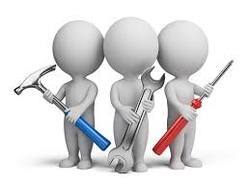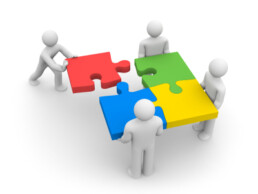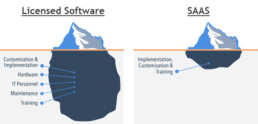Here is what to know:
- A History Lesson
- A New, Disruptive Technology Environment
- The Subscription Economy
- A New Value Proposition
- Conclusion

A History Lesson
There’s an old riddle about confronting change, and it goes like this.
Q: “How many folk singers does it take to change a lightbulb?”
A: “Four. One changes the light bulb, while the other three sing a song about how much better the old one was.”

Ever-changing technology trends can be like that, too. In fact, humans aren’t wired nearly as well for change as they are for routine and habit. Hence, the primary pain point for evolving technologies…hype for new and updated Apple products notwithstanding.
How many of us cursed our software providers when releasing updates or even altogether new versions, sometimes leaving our computers oddly unstable? “What the hell, the old version works just fine!” Until it doesn’t, of course. Just ask anyone working on Microsoft Windows 7 or 8.1 in need of support…God help ‘em, because Microsoft won’t. Intuit regularly ceases support for Quickbooks desktop software. Oh, and Act! corporate continually lowers how long they’ll support each version. The business models cannot support legacy versions while users desire new features.
Many of my clients have shared this kind of frustration with me over the years. For example, once upon a time, Act! for Windows worked seamlessly with Microsoft Outlook with minimal suffering. When the connection became unstable and unreliable, my phone rang constantly with terrified and unhappy clients. In fact, the consultants like me wind up holding the bag because it’s a blame game between Act! corporate and Microsoft to determine fault. To provide support, I wound up creating several blog posts to help our clients so they could try to fix it themselves before paying us. For this integration, Act! corporate must resort to a subscription model to fund the developers to keep pace with Microsoft’s changes. Or, we sell third party Act! addons. In short, it remains an inefficient, sometimes chaotic ecosystem for technology to evolve, and ripe for disruption.


We began to realize that keeping and maintaining essential software was very different from, say, the car-buying experience where one can keep their existing car for several years if they diligently maintain it. Continuing with the auto industry analogy, this whole turnover cycle angered technology users just as when it was revealed that GM, Ford and Chrysler were all guilty of a “planned obsolescence” business model for years, eventually building cars in the 70s that only lasted a few years before breaking down. All of us old enough to remember were suspicious Apple was up to the same shenanigans releasing a newly hyped iPhone every year with marginal upgrades to previous models. It all begins to feel like a scam after a while, doesn’t it?
A NEW, DISRUPTIVE TECHNOLOGY ENVIRONMENT

But the software industry operates a bit differently from hardware and automobiles. It has a different supply chain, different stresses on user experience, and frankly, operates in a different technology environment—like fish surviving in water vs. humans surviving on oxygen. Referring back to the auto industry for comparison, ubiquitous access to high-speed internet and 5G technologies are the tech equivalent of making traditional roads obsolete…or even the ownership model altogether. (One notable exception is Elon Musk’s Tesla. His management team is populated by ex-Apple people and their business model was designed very similarly as a platform complete with periodic software updates.)
Advancements like universal access to high-speed internet and 5G technologies essentially created a matrix, and we were no longer constrained by cables, hardware or networks. As a result, people expect to operate at full function wherever they are, 24-7. These new developments make software less dependent on local hardware and operating system configurations as long as it was operating on the World Wide Web.
THE SUBSCRIPTION ECONOMY

This new environment brought new possibilities to commerce everywhere and the modes which people do business began to change, too. Much ink has been spilled telling us we now live in a subscription economy, and the data to supports it. The Washington Post reported the U.S. subscription-based economy was valued at $650 billion in 2021, and expected to more than double to $1.5 trillion by 2025. If we just look around us, we see subscriptions for more than just our television programming and news content—hotels, car washes, music, cloud storage, food and meal delivery, movie theaters, home workouts, even GM launches a subscription-based auto membership experience beyond the conventional lease model.
A NEW VALUE PROPOSITION

Most of us remember when we’d bite the bullet every few years and spend $250 – $400+ per PC + I.T. contractor costs to upgrade Microsoft Office. As a result, people collaborating on projects often weren’t working on the same version. Google Docs essentially made that model obsolete, and now annual Microsoft Office subscriptions are priced very affordably starting at $69 per user per year.
- 24-7 access to your data with internet connection, no matter where you are or machine you use
- Lower onboarding costs
- Providers monitor friction points in real time, constantly improving features and functionality
- Reduced technical support costs
- Developers can deploy updates quickly
- No more brutal software installs or data migrations
- No servers to own and maintain
- The Cloud offers better overall data security
- Addresses compliance when and where relevant
- Lower cost of entry and total cost of ownership
- Subscription pricing tiers mean you only pay for the features you use
- Subscriptions motivate SaaS providers to continually provide
goodgreat service.
But the benefit few people talk about (but Mondo clients know!) is subscription pricing often frees up money for customizing the software to work seamlessly with your business processes rather than having to adapt your processes to counter the software’s limitations.
Conclusion

The Bottom-line? Subscription-based software just works better than the old desktop delivery model when users require constant updates that Microsoft, Apple or Google dictate. If it didn’t, the industry would go back to the old way. It’s simply more reliable, more adaptable and more cost-effective. And while there are still some single users inclined to sing a song about how much better the old way was, the new way is just better.
Related Posts
April 20, 2023
MondoCRM Acquires WiredContact UK
November 1, 2022
A 25 YEAR JOURNEY TO NOW
October 16, 2019


